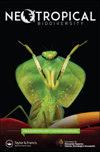Sampling performance of bait traps in high Andean fruit-feeding butterflies
IF 0.9
Q4 ECOLOGY
引用次数: 1
Abstract
ABSTRACT Studies on model organisms such as butterflies are useful tools for conservation decision-making. However, in tropical ecosystems with an intrinsic high diversity a full understanding of biotic communities is difficult to obtain. Bait trap samplings have traditionally been used for community appraisals related to ecological and conservation issues. Nonetheless, in the Andes Mountains, there is little knowledge related to the effectiveness of bait traps for butterfly sampling. In this study, we tested the success of fermented fruits and rotten fish baits for butterfly sampling in four land-cover types (páramo, cloud forests, mixed, and pasture) in the upper Rio Chico basin of the northern Central Cordillera of the Colombian Andes. A butterfly survey was conducted between 2011 and 2014, in an elevation range of 2650 to 3300 masl, within a total of 132 field days. Three sampling units for each land cover were established with four standard Van Someren-Rydon traps (VSR) per sampling unit. Traps were baited alternatively with fermented fruits and carrion (rotten fish). All 57 recorded species were captured using rotten fish, while approximately 65% (37 species) were collected from fermented fruit. Moreover, species richness was higher in all sampled land covers using rotten fish bait, but the dominant species in the land covers differed between baits. The rotten fish bait proved to be highly effective for butterfly sampling in páramo and cloud forest, although the combination of traps baited with fermented banana and rotten fish, allowed the collection of data suitable for comparison among all studied land cover.高安第斯山脉食果蝴蝶诱饵器取样性能
蝴蝶等模式生物的研究是保护决策的有效工具。然而,在具有内在高度多样性的热带生态系统中,很难获得对生物群落的充分了解。传统上,诱捕饵器取样用于与生态和保护问题有关的社区评估。然而,在安第斯山脉,关于蝴蝶取样的诱饵陷阱的有效性的知识很少。在这项研究中,我们测试了发酵水果和腐烂鱼饵在四种土地覆盖类型(páramo、云雾林、混合和牧场)中蝴蝶取样的成功率。2011年至2014年期间,在海拔2650至3300米的范围内进行了蝴蝶调查,共进行了132天的野外调查。为每个土地覆盖建立了3个采样单元,每个采样单元使用4个标准Van Someren-Rydon陷阱(VSR)。诱捕器交替使用发酵水果和腐肉(腐烂的鱼)作为诱饵。所有记录的57种均采用腐鱼捕获,而发酵水果捕获约65%(37种)。腐鱼饵料对不同饵料土地覆被的物种丰富度影响较大,但不同饵料土地覆被的优势物种存在差异。在páramo和云雾森林中,腐烂的鱼饵被证明是非常有效的蝴蝶采样方法,尽管用发酵香蕉和腐烂的鱼作为诱饵的陷阱组合,可以收集到适合于所有研究土地覆盖之间比较的数据。
本文章由计算机程序翻译,如有差异,请以英文原文为准。
求助全文
约1分钟内获得全文
求助全文
来源期刊

Neotropical Biodiversity
Environmental Science-Ecology
CiteScore
1.80
自引率
0.00%
发文量
39
审稿时长
24 weeks
 求助内容:
求助内容: 应助结果提醒方式:
应助结果提醒方式:


